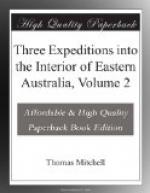The morning was frosty and clear. Soon after we left our encampment we came to a ridge or berg, bare of trees with the exception of a fine clump on the highest part; and behind it was an extensive flat which was also destitute of wood, only a few atriplex bushes appearing upon it. I sent the carts across this flat while I rode along the crest of the ridge. The sea of reeds skirted this ridge on the north, and a meandro-serpentine canal full of water intersected the reedy expanse in almost all directions. The river flood had not reached it, at least if it had the water continued unmoved by any current. I perceived some smoke arising from the reeds at the distance of a mile, and at the extreme point of a tongue of firmer ground which extended into them.
PIPER SPEAKS TO NATIVES ON THE RIVER.
Piper went boldly up to the fire and found three families of blacks in as many canoes on the river. They told him there was a junction of rivers some way ahead of us; and I understood him to say that part of these natives had come across from Waljeers. The country opened more and more as we proceeded, and the basin of reeds was more extensive. The bergs on the opposite side (on which I had fixed several points) were distant on an average about eight miles, which was the breadth therefore of that low margin of reeds. The winding borders of this plain terminated on our side in rich grassy flats, some of which extended back farther than I could discover; and on two of these plains I perceived fine sheets of water, surrounded by shining verdure and enclosed by sheltering hills clothed with Callitris pyramidalis.
GOOD LAND ON THE MURRAY.
One or two spots seemed very favourable for farms or cattle stations. The soil in these grassy flats was of the richest description: indeed the whole of the country covered by reeds seemed capable of being converted into good wheat land, and of being easily irrigated at any time by the river. This stream was also navigable when we were there, and produce might be conveyed by it at such seasons to the seashore. There was no miasmatic savannah, nor any dense forest to be cleared; the genial southern breeze played over these reedy flats which may one day be converted into clover-fields. For cattle stations the land possessed every requisite, affording excellent winter grass back among the scrubs to which cattle usually resort at certain seasons; while at others they could fatten on the rich grass of the plains, or during the summer heat enjoy the reeds amid abundance of water. We found on these plains an addition to the common grasses.* The fine open country afforded extensive views, and to the eastward and south-east we saw hills with grassy sides and crowned with callitris.
(Footnote. An Andropogon allied to A. bombycinus.)
WOOD AND WATER SCARCE.




